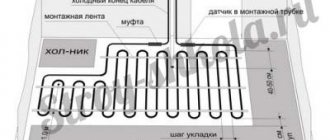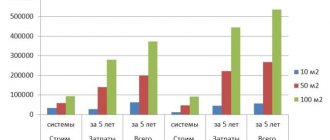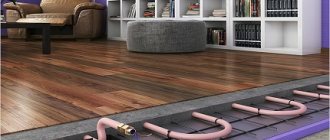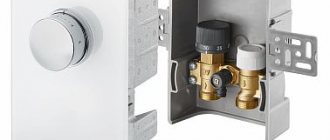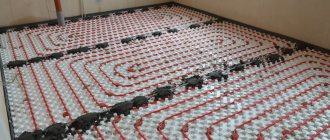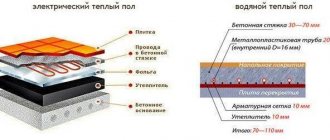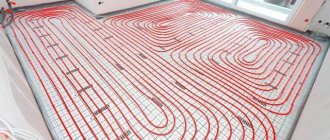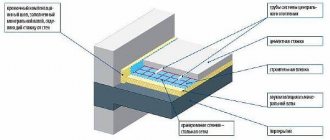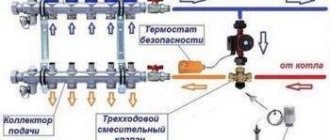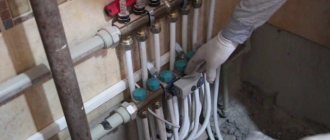Among the numerous equipment that is involved in the operation of underfloor heating systems, you can find a small device that plays a vital role in controlling and adjusting the heating system. This is a servo drive, an electromechanical device, without which automatic temperature control for a warm water floor is not possible.
The device is based on an electrothermal reaction to a change in the heating temperature of the coolant in the main supply pipe and subsequent mechanical action, which together ensures the opening or closing of the flow of hot water into the heating circuits. Servo drives or servomotors, officially in the language of professionals the device is called an electrothermal servo drive, are present today in almost all autonomous heating systems. New suburban residential buildings, cottages and dachas equipped with heated floors are equipped with heated floors, which are controlled by servo drives. It is the servo drive installed on the manifold for underfloor heating that performs the task of regulating the flow of coolant in the water floor heating system.
Existing types of servos today
Among the regulators that exist today and have become widespread in everyday life, the following servos are found. All devices can be divided into several types. Each type has a different operating principle and functionality. There are two types of device design:
- closed;
- open.
By the names you can judge the principle of operation. Enclosed servos typically remain open when no power is supplied. The incoming signal activates the mechanical part, blocking the access of water to the system. For open-type devices, the operating principle is reverse. In the normal state, the servo drive is closed; only when a signal is received, the mechanical part is activated, opening the flow of water into the pipeline. You can judge which type is best suited for domestic use by assessing the capabilities of your own heating system and the climatic conditions outside the window. Normally open servos are most often used in our country.
Note: if the device fails, the coolant in the pipeline continues to circulate, leaving the floor warm for a certain time. This feature is especially relevant for country houses located in a cold climate zone.
According to the method of power supply, servomotors are divided into devices powered by a constant flow voltage of 24V and devices connected to a regular AC power supply of 220V. Servo drives with 24V power supply are equipped with inverters.
Often consumers use another, rather rare type of device. We are talking about devices that are set to their normal position depending on the technological requirements of the heating system. Such servos are called universal and can change functionality from a normally open state to a normally closed state, and vice versa.
All three types of servomotors can be connected to the collector. The only condition is the correct setting, balancing and operating conditions of the heating system.
Servo valve: how to choose
Servo drives are used in the operation of heating and plumbing systems. They are installed on the collector when installing heated floors, or on radiators in the room. Thanks to servo drives, control of the heating system becomes automatic.
Types of servos:
- Open. In idle mode they remain open and close when power is supplied.
- Closed. In the inactive state they are in the closed position; they open when power is applied. If there is no electricity, the coolant does not enter the system.
For heating systems only enclosed actuators are used. They have a threaded union nut and can be installed on standard radiator valves.
Today, there are many manufacturers that produce servos and other elements for heating and water supply systems. It is difficult to say which manufacturers are better, since each model has both advantages and disadvantages.
Among the leading manufacturers of servo drives are VALTEC and Watts.
REHAU produces servo drives for installing heated floors, LUXOR, in turn, concentrated on the production of elements for installation in autonomous heating systems.
Installation and operation of servos must be carried out strictly according to the instructions from the manufacturer - the operation of the entire heating system of the house depends on correct installation.
Well-thought-out and high-quality piping in an apartment allows you to avoid many problems in the future. Read advice from professionals on the website:
Criteria for selecting the type of servo drive
In this section we will try to answer the question. What is the basis for the choice of devices of one type or another?
If you decide to equip your “warm water floor” heating system with servo drives, take into account the operating parameters of your heating. In what position should the valve be most of the time? In a situation where a heated floor is your main option for heating residential premises, when hot coolant constantly enters the pipeline, rely on a normally open servomotor. This type is ideal during a long heating season.
Note: in case of interruptions in the electrical supply, failure of the device will not stop the circulation of warm water in the heating water circuits. The heated floor will continue to be supplied with treated water as a coolant.
For regions with warm climates, a normal closed servomotor is suitable. If you are not afraid of defrosting the heating circuit, and you periodically turn on the underfloor heating, this device will cope with its functions quite well.
Important! The servo drive for heated floors with smooth adjustment has an electronic regulator. Such devices respond more accurately to changes in the temperature of the coolant flow, smoothly moving the rod to the required position. Servomotors with smooth adjustment are designed for heated floors, in which it is often necessary to dose the volume of incoming flow.
In most cases, such devices are not used in home heating systems with underfloor heating. Therefore, when purchasing, pay attention to whether or not the installation of an electronic regulator is required for the device. If the instructions say that such equipment is necessary, then you are dealing with an electronic servo drive. Let’s say right away that using such a device at home is impractical and unprofitable.
Be sure to read: how to make a water floor from a gas boiler?
What is a servo drive and how it works
A servo drive is a self-contained electrical device that rotates machine parts with high efficiency and great precision. The output shaft of this motor moves to a certain angle, position and speed, which a conventional motor does not have the ability to do. The servo motor uses a regular motor and connects it to a sensor for positioning feedback. The controller is the most important part of the servo motor designed for this purpose.
The element is a closed-loop mechanism that includes position feedback to control rotational or linear speed and position. The motor is controlled by an electrical signal (analog or digital), it determines the amount of movement that represents the final command position for the shaft. The encoder type is determined by the sensor, providing speed and position feedback. This circuit is built directly inside the motor housing, which is usually equipped with a gear system. A servo drive for heated floors from Aliexpress saves time and money, but it is also available in other stores.
The main difference between a servomotor and a motor is that it is controlled by torque, as well as position and speed. Main types of devices:
- asynchronous;
- synchronous;
- direct and alternating current.
Design and principle of operation of servomotors
The main working element of the servo drive is the bellows.
Those. the same part as in the three-way valve. A small, sealed cylinder with an elastic body is filled with a substance that is sensitive to temperature. Depending on whether the temperature increases or decreases, the volume of the substance changes accordingly. The figure - diagram clearly demonstrates the structure of the servomotor, where the bellows occupies the main place. The bellows is in close contact with the electric heating element. Receiving a signal from the thermostat, the heating element is switched on from the mains and starts working. Inside the bellows, the substance is heated and increases in volume. Thus, the cylinder, which has increased in size, begins to put pressure on the rod, changing its position and blocking the path of coolant flow. Evaluating the operation of the servo drive, we can conclude that the device is not equipped with any motors, it does not have any gears or transmission links. The usual working connection is “thermal energy and electricity”. Hence the common name for the devices, thermoelectric regulators.
In order for the valve to become open again, the entire process is repeated only in the opposite direction. Lack of power causes the heating element to stop working. Consequently, the substance inside the cylinder cools, decreasing in volume. The pressure on the rod decreases, it rises, acting on the valve, and, consequently, hot water access to the system opens.
Note: the substance placed inside the cylinder is toluene, which has high thermodynamic characteristics. The electric heating element is a nichrome thread.
Having become familiar with the principle of operation of the device, it is important to remember that the mechanical action of the valve requires a certain time. Despite the fact that when a signal is received from the thermostat, the heating element begins to heat the substance inside the cylinder. The time required for changes in the physical state of the liquid is 2-3 minutes, so the valve is not activated immediately.
For reference: when choosing a servo drive model, pay attention to the parameters of the heating element and the heating time of the liquid specified in the device passport.
Unlike heating, cooling of a liquid occurs more slowly. To the reverse process, i.e. Closing the valve will no longer take 2-3 minutes, but 10-15 minutes. If overheated, each servomotor should automatically turn off. For this purpose, the design provides an emergency shutdown mechanism.
For example: the servos used in the operation of the collector group are not all equipped with cylinders and cylinders with a substance. There are models in which this role is played by thermocouples, resembling a spring or plate, which heat up under the influence of the same heating element. Expanding, these parts again act on the rod, ultimately bringing the valve into working condition. You can determine what position the valve is in by changing the appearance of the servomotor. The retractable element signals the operation of the device. If this does not happen, it means that your device is not connected correctly or the heating system is not working properly.
For reference: a servomotor that is hot to the touch means that in this case the device is closed and turned off. If the device is cool to the touch, therefore, the valve is open, the coolant circulates normally through the water circuits of the heated floor.
What elements are included in the control of the Salus IT 600 smart home?
- The thermostat (thermostat) of the VS 10 RF/VS 20 RF series is a remote control for heating or underfloor heating in the room where they are located. On its display you can see the temperature in the room, make it higher/lower, set operating parameters depending on your needs (Vacation, Departure, Party, Night), set the on time, etc. VS10RF / VS20RF thermostats can be combined into groups with a master thermostat and slave thermostats (for example: “warm floor 1st floor” group, “heating 2nd floor” group, etc.), after which the slave thermostats will obey commands from the master thermostat. You can also additionally connect an external sensor to each thermostat for more precise control of the heated floor temperature. The difference between the VS10RF thermostat and the VS20RF is that this thermostat can be built into a wall, while its minimum thickness becomes 16.5 mm, and you also do not have to change the batteries in this thermostat, since its power comes from a 220 volt network (but for this It is necessary to install a wall box for the thermostat and supply power wires to it). The letter W in the VS 10WRF / VS 20 WRF thermostat model is white, the letter B in the VS 10BRF / VS 20BRF model is black.
- The FS 300 heated floor sensor is necessary for correct control of the temperature of heated water floors. Connects to thermostats VS 10RWRF/VS20BRF and “removes” the temperature of the surface of the heated floor or inside it. Length 3m.
- Wireless thermal heads TRV10RF / TRV10RFM. Used to regulate the temperature of heating radiators. Suitable for most control radiator thermal valves on the market (standard thread M 30×1.5). The wireless thermostatic head TRV10RF is controlled via a radio channel from thermostats of the VS10RF/VS20RF series through the SALUS C10RF coordinator. One thermostat can control the operation of six thermostatic heads TRV10RF/TRV10RFM (update the firmware if necessary, since in older versions only 3 thermal heads can be controlled), which is very convenient in terms of automation of the heating system, and also makes it possible to integrate each radiator into the overall heating control system. Wireless thermal heads for Salus radiators of the TRV10 series set a high level of comfort in the room, as they regulate the room temperature according to data from a thermostat located at a distance, without being influenced by hot air near the radiator. These thermostatic heads for radiators are also necessary in rooms where radiators are covered with screens or grilles. The thermal head control is touch sensitive. The TR10RF model differs from the TRV10RFM model only in size (58x106x58 and 50x83x50, respectively). Salus thermal heads are powered by batteries.
- ZigBee CO10RF network coordinator is a heating and underfloor heating control unit. Through this coordinator, all elements of the IT 600 system interact: thermostats, thermostatic heads, switching centers, remote control modules for the heating boiler and pumps. Roughly speaking, this is the “brain of the system”, which receives information from all elements of the Salus IT 600 system, analyzes it and carries out further comprehensive management. Thanks to it, an automatic heating control system works, automatic control of a heated floor, and when connected to the G30 Internet gateway, a connection to the Internet is established. The CO10RF coordinator can service 30 TRV10RF/TRV10RFM thermostats, 8 KL series switching centers, 90 thermal heads.
- Internet gateway G30 - allows you to control heating via the Internet. Salus G30 connects the CO10RF network coordinator (connects to the Internet gateway via a USB connector) with the user’s device. You can control the Salus IT 600 smart home system via the Internet from a phone with IOS, Android, Windows operating systems or from a personal computer. Up to 10 SALUS thermostats of the VS 10/VS20 series can be connected to the gateway. The gateway will only work if there is a Wi-FI network in the house.
- Wireless 8-zone switching center KL 10RF and wireless 8-zone switching center KL08RF is a heating or underfloor heating control controller that receives a signal from VS10/VS20 series thermostats through the CO10RF coordinator and transmits it via wires to T30NC electrothermal actuators to control the rod on heating manifolds or underfloor heating. Thanks to this, the operation of the water floor or heating circuits is regulated. Up to 6 collector circuits (6 electrothermal drives) can be connected to one zone of the KL10 RF strip, and up to 3 collector circuits can be connected to one zone of the KL08 RF strip (the number can be increased by purchasing a special relay). Up to 8 heating zones (rooms, premises, locations) are connected to the Salus KL10RF switching center, and to the Salus KL08RF, with the purchase of an additional expansion (4-zone wireless expansion module KL04RF) up to 12 heating zones (for example, 6 heating zones and 6 heated floor zones ). For KL10RF, the CO10RF coordinator is purchased in addition, for KL08RF it is supplied as a kit. In switching centers you can use a jumper (included) to distribute thermostats VS10 and VS20 into 2 groups (for example: heating of the 1st and 2nd floors, or “radiator heating” and “warm floors”, depending on the configuration of your system) and control the pumps of these groups. Both strips allow you to turn the boiler and pump on and off. A thermostat can be connected to the KL 10RF switching center to control the hot water supply on and off (there is no such function in the KL 08RF switching center). With certain settings, these strips can also operate in COOLING mode.
- Thermoelectric servo drive SALUS TC30NC 230 - performs the function of opening/closing the flow area of the collector circuits, two- or three-way taps, radiator valves by receiving a signal from the control unit of the heating system or underfloor heating KL10RF or KL08RF. By increasing/decreasing the flow passing through the coolant cross-section, the temperature of the heating system and the temperature of the heated floor are controlled. Connection to these patch strips is carried out via wires. Servo drives SALUS TC30NC have a standard connection - M 30×1.5. Thanks to the convenient top bracket, they can be mounted very quickly onto the thread of the control device.
- Additional module RX10RF – provides remote control of the heating boiler and pump. Works in a single Salus IT 600 network in 2 versions: as a boiler receiver RX1 and as a receiver controlling one zone RX2, for example: a) a heating control device that turns the circuit pump on/off b) a heated floor temperature control that turns the pump or mixing pump on/off valve. Only two additional RX10RF modules can be connected to the IT 600 system. You can also use it to manually turn on the devices that are connected to it.
- Additional elements for smart home control: • Wi-FI repeater SALUS RE10RF - is necessary to strengthen the signal from thermostats of the SALUS VS10WRF/VS20WRF series (VS10BRF/VS20BRF), if the distance between them is large enough or, if the number of thermostats powered by batteries (VS20WRF/ VS20BRF), more than 32 pcs.
- • Salus 08RFA - additional antenna for the KL08RF.. switching center.
Attention!
Thermal heads TRV10RF are no longer produced! TRV10RFM wireless thermal heads remain in the product line , as they provide longer battery life and are much more compact.
Servo drive installation. Features and nuances
Before installing the servo drive, decide what type of thermostat the device will have to interact with. In cases where the thermostat controls the operation of one water circuit, both devices are directly connected to each other by wires. When it comes to using a multi-zone thermostat, a device that serves several pipelines at once, the servomotors are connected as follows.
To correctly connect all the wires and terminals, a heated floor switch is used. The functions of this device include connecting and connecting devices for various purposes into a single circuit. In addition to the distribution and communication functions, the switch also plays the role of a fuse. In situations where all shut-off valves of the water circuits are closed, the switch turns off the power to the circulation pump.
The switch is very convenient in cases where heated floors are powered by an automated autonomous gas boiler. The figure shows how thermostats and servos are connected to a single control system.
Servo drive installation location, thermostatic valve installed on the manifold.
Important! When the heating system operates underfloor heating from a solid fuel boiler, a switch function such as turning off the pump can stop the heating device itself. Installing a bypass and bypass valve will allow you to avoid stopping the pump and running the heater idle.
conclusions
It should be noted that thanks to the advent of modern devices and devices, managing and adjusting heated floors has become a commonplace and simple process. The design of many devices used to operate heating circuits is not particularly complex. The operating principle of many components and assemblies is also clear. This can be said with confidence about servos. The devices are mostly reliable, practical and easy to use. Thanks to servomotors, it has become possible to fully automate the control system for heated floors, making the conditions for using heating equipment simple and understandable.
By choosing a simpler option, you can get by with installing conventional control valves. Automatic regulators, temperature sensors and servos are a category of devices that work for your comfort and safety. Installing additional devices, such as a switch and a bypass valve, will make your heating system as efficient and safe as possible.
